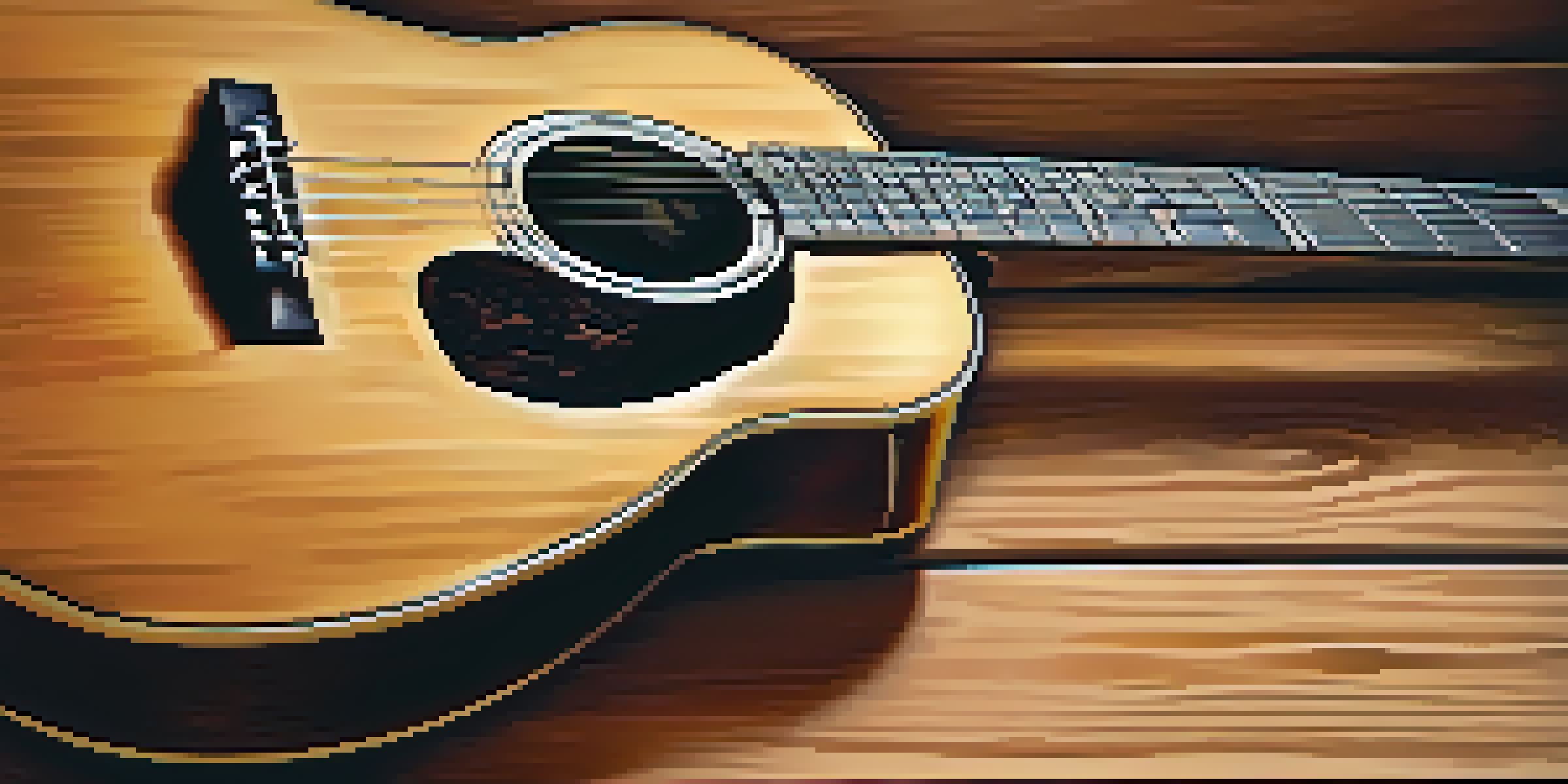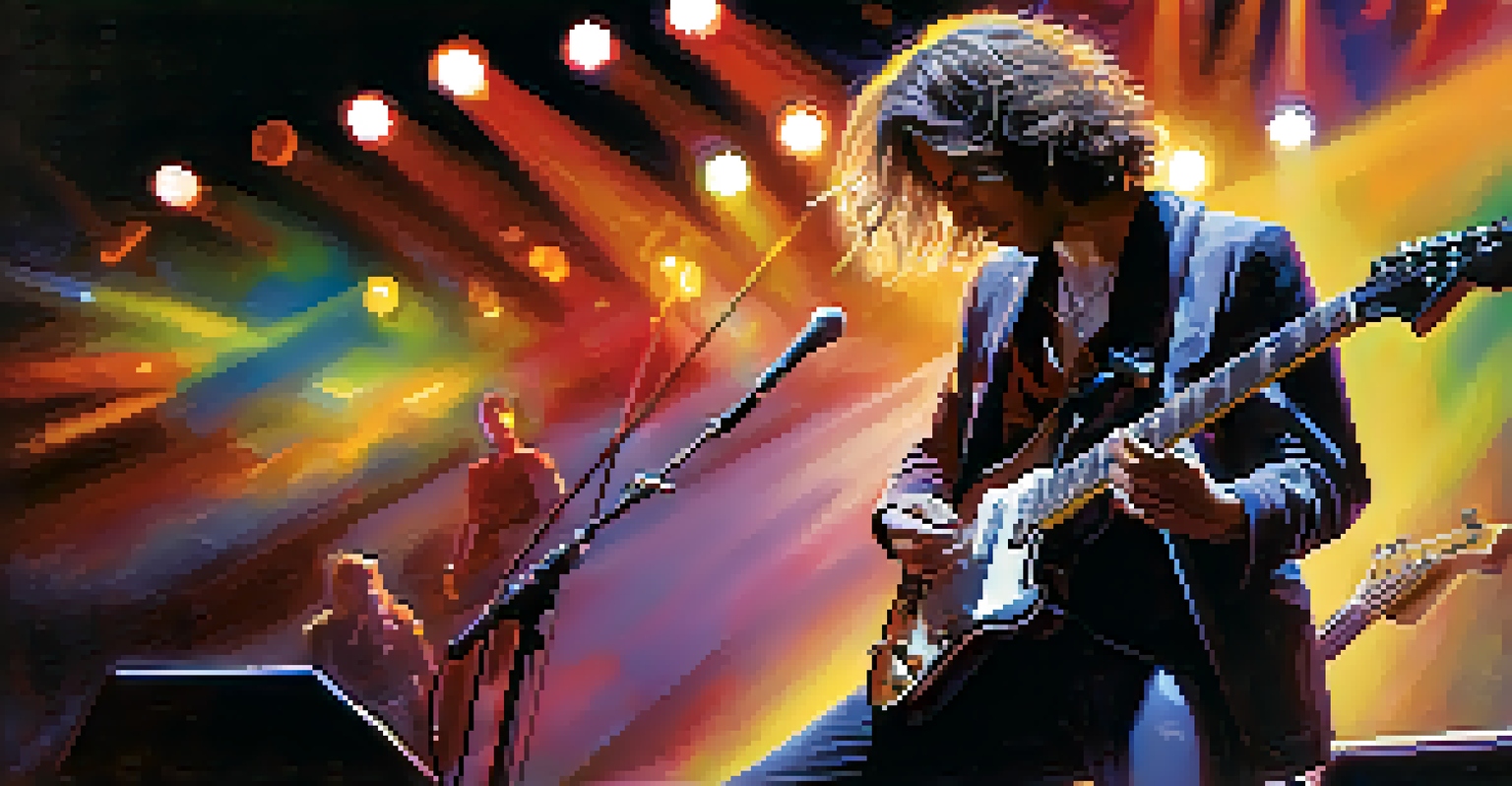Essential Guitar Techniques for Beginners: Getting Started Right

Understanding the Parts of Your Guitar
Before diving into playing, it's crucial to familiarize yourself with the parts of your guitar. Understanding the body, neck, strings, and fretboard will make your learning process smoother. Each component plays a vital role in producing sound and your overall playing experience.
Music is the shorthand of emotion.
For instance, the body is where the sound resonates, while the fretboard is where you press down the strings to create notes. Knowing these parts helps you appreciate how they work together to make music. Plus, it sets a solid foundation for your understanding of guitar maintenance and care.
So, take a moment to explore your guitar. Identify each part and get comfortable with its function. This knowledge will empower you as you progress and start to create your own music.
Holding the Guitar Correctly for Comfort
Proper posture is essential for any guitarist, especially beginners. Holding the guitar correctly not only enhances your comfort but also improves your playing technique. Whether you’re sitting or standing, ensure that the instrument is positioned in a way that feels natural.

When sitting, keep your back straight and hold the guitar close to your body, resting it on your right leg if you're right-handed. This position allows your left hand to easily navigate the fretboard. Standing? Use a strap to support the guitar and maintain a relaxed stance to prevent fatigue.
Know Your Guitar's Parts
Familiarizing yourself with the guitar's components enhances your learning and appreciation for music.
Remember, comfort is key! If you feel strained or awkward, adjust your position. As you practice, a good posture will help you play longer and get better faster.
Basic Finger Placement for Chords
Learning how to place your fingers correctly on the fretboard is a fundamental skill for any guitarist. Start with your index finger pressing down on the string just behind the fret, which helps produce a clear sound. Each finger has a designated role when forming chords, making it essential to practice finger placement.
The beautiful thing about learning is that no one can take it away from you.
For example, when playing a C major chord, your fingers should be positioned in a specific way to ensure that all the notes ring out clearly. You might find it challenging at first, but with time and practice, your fingers will become more agile and accurate.
To aid your learning, try practicing simple chord progressions. This will not only improve your finger placement but also help you get comfortable transitioning between chords smoothly.
Strumming Techniques for Rhythm
Strumming is where you start to feel the rhythm of your music. It’s about more than just moving your hand back and forth; it involves timing and dynamics. Begin with simple downstrokes, using either a pick or your fingers, and focus on keeping a steady beat.
As you build confidence, experiment with upstrokes and varying the intensity of your strumming. For instance, playing softly can create a delicate feel, while strumming hard can add energy to a song. This dynamic control is what brings your music to life.
Practice Routine is Key
Establishing a consistent, focused practice routine helps you progress steadily in your guitar skills.
Don't hesitate to play along with your favorite songs. This practice will help you develop a sense of timing and groove, which are essential for any guitarist.
Finger Exercises to Build Strength
Developing finger strength and dexterity is crucial for progressing on the guitar. Simple exercises, like finger stretches and chromatic scales, can significantly enhance your playing abilities. These exercises not only build strength but also improve your coordination.
For example, try playing each note on the fretboard sequentially, using different fingers. This will help you get accustomed to moving your fingers independently and quickly. Consistency is key, so dedicate a few minutes each day to these exercises.
As your fingers grow stronger, you’ll notice a difference in your ability to play chords and melodies. Plus, strong fingers will reduce the risk of injury as you tackle more complex techniques.
Learning Simple Songs to Apply Techniques
One of the best ways to solidify your guitar skills is by learning simple songs. Choose songs that incorporate the chords and strumming patterns you've been practicing. This not only keeps you motivated but also makes the learning process enjoyable.
For instance, songs like 'Knockin' on Heaven's Door' or 'Three Little Birds' are great for beginners because they use just a few chords. Playing along with your favorite tracks will also help you develop your timing and rhythm.
Stay Motivated and Have Fun
Surrounding yourself with supportive influences and celebrating small achievements keeps your guitar journey enjoyable.
Remember, it's about having fun while you learn! Don’t be afraid to play along with friends or family, as music is always more enjoyable in good company.
Developing a Practice Routine for Success
Establishing a consistent practice routine is vital for your growth as a guitarist. Aim for short, focused sessions rather than long, overwhelming marathons. Even 20-30 minutes daily can lead to significant progress over time, so find a schedule that fits your lifestyle.
Include a mix of techniques in your practice—chord changes, strumming, finger exercises, and learning songs. This variety keeps things interesting and helps reinforce what you've learned. Plus, it prevents burnout by keeping your practice sessions fresh.

Lastly, set realistic goals for each session. Whether it’s mastering a new chord or playing a song through without mistakes, having clear objectives will keep you motivated and provide a sense of accomplishment.
Staying Motivated on Your Guitar Journey
Learning guitar is a journey, and like any journey, you’ll face ups and downs. Staying motivated is crucial, so surround yourself with positive influences. Whether it's joining a guitar group, taking lessons, or simply sharing your progress with friends, find a community that inspires you.
Additionally, celebrate your milestones, no matter how small. Did you finally get that chord change right? Awesome! Reward yourself and acknowledge your hard work. This positive reinforcement will keep your spirits high and encourage you to keep pushing forward.
Lastly, remember to have fun! Explore different styles of music, try writing your own songs, and enjoy the learning process. The more you enjoy it, the more likely you are to stick with it and become the guitarist you aspire to be.